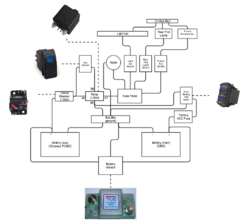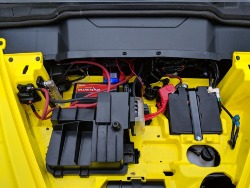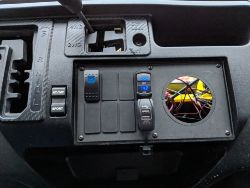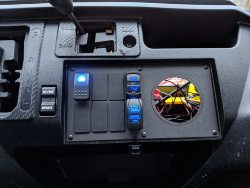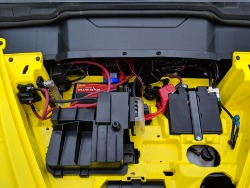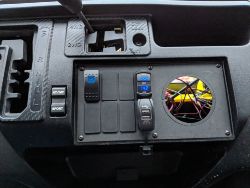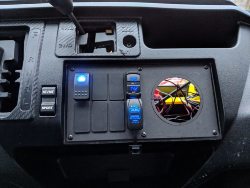T
So I've ordered everything for my dual battery setup plus more, and diagramed it all out and wanted to get some feedback.
Here's the diagram (v2):
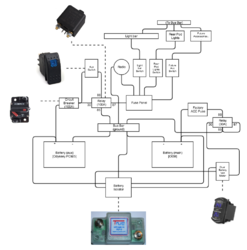
So hope it makes sense. I'm no master electrician, but I feel I have a good understanding of what I am doing and trying to achieve. I know the diagram leaves some things out, so take it with a grain of salt. I haven't bought a radio yet, but likely will go with the Rockford Fosgate PMX-3. Haven't bought a light bar, but if it's rated for >15A, I will likely put it on a relay instead of direct to the switch. Same for the light pods, as I will have 2 pods wired together (but they should be fine direct to the switch).
For clarification, the dashed lines are NOT connections, but simply a line leading to an image of what exactly I have.
I do have a couple questions that I hope someone can help me sort out.
1) So for my "Dual Battery Volt Meter", on the "Aux Battery" side, I have it wired to 85 on my relay. Is this acceptable? Should I instead wire it on 86 side of it? Should I add an inline fuse?
2) So for my "Aux Switch", is there any problem with me connecting it, as well as the relay, coming from the output side of my Circuit Breaker? Circuit Breaker to 30 on my relay I will be using a 6AWG wire, but the switch will be using 18AWG wire. Should I add a 1A (or bigger?) fuse inline before the switch? The switch is rated for 20A.
3) I'm also toying with the idea of a low voltage disconnect. I know I can get a beefy 100A disconnect and wire that between the Circuit Breaker and Relay, but I feel like a smarter option would be a 20A (or less?) disconnect before the "Aux Switch". If Aux Battery voltage drops below 11.0V disconnect the switch to the relay, so opening the high-current side of the relay, regardless of the switch in the cab. Reconnect once Aux Battery reaches 12.0V. Something like that.
Thoughts? Feedback? Anything is appreciated!
Here's the diagram (v2):

So hope it makes sense. I'm no master electrician, but I feel I have a good understanding of what I am doing and trying to achieve. I know the diagram leaves some things out, so take it with a grain of salt. I haven't bought a radio yet, but likely will go with the Rockford Fosgate PMX-3. Haven't bought a light bar, but if it's rated for >15A, I will likely put it on a relay instead of direct to the switch. Same for the light pods, as I will have 2 pods wired together (but they should be fine direct to the switch).
For clarification, the dashed lines are NOT connections, but simply a line leading to an image of what exactly I have.
I do have a couple questions that I hope someone can help me sort out.
1) So for my "Dual Battery Volt Meter", on the "Aux Battery" side, I have it wired to 85 on my relay. Is this acceptable? Should I instead wire it on 86 side of it? Should I add an inline fuse?
2) So for my "Aux Switch", is there any problem with me connecting it, as well as the relay, coming from the output side of my Circuit Breaker? Circuit Breaker to 30 on my relay I will be using a 6AWG wire, but the switch will be using 18AWG wire. Should I add a 1A (or bigger?) fuse inline before the switch? The switch is rated for 20A.
3) I'm also toying with the idea of a low voltage disconnect. I know I can get a beefy 100A disconnect and wire that between the Circuit Breaker and Relay, but I feel like a smarter option would be a 20A (or less?) disconnect before the "Aux Switch". If Aux Battery voltage drops below 11.0V disconnect the switch to the relay, so opening the high-current side of the relay, regardless of the switch in the cab. Reconnect once Aux Battery reaches 12.0V. Something like that.
Thoughts? Feedback? Anything is appreciated!
Attachments
Last edited:


